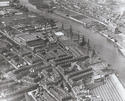 Govan had been a burgh from 1864 until 1912 when it finally became part of Glasgow. By 1914 its fame and prosperity was firmly established on shipbuilding and allied trades. Brotchie described it as: "One of the great workshops of the world. Within its boundaries, it is impossible to get beyond the sound of the hammer. From early morn till late at night, we hear the continuous hum of industry". However, from 1918, with few exceptions such as during the Second World War, fortunes gradually waned and, although Sir Murray Stephen had confidently predicted in 1950 that "shipbuilding would not go the same way as weaving", those "glory days" were slowly and inexorably passing into memory.
Govan had been a burgh from 1864 until 1912 when it finally became part of Glasgow. By 1914 its fame and prosperity was firmly established on shipbuilding and allied trades. Brotchie described it as: "One of the great workshops of the world. Within its boundaries, it is impossible to get beyond the sound of the hammer. From early morn till late at night, we hear the continuous hum of industry". However, from 1918, with few exceptions such as during the Second World War, fortunes gradually waned and, although Sir Murray Stephen had confidently predicted in 1950 that "shipbuilding would not go the same way as weaving", those "glory days" were slowly and inexorably passing into memory.
 During the rise of industrial Govan the population had increased from 9,000 in 1864 to 95,000 by 1907 but its steady fall, to around 35,000 by the mid-1950s, was not solely attributable to a deteriorating industrial climate. The spectacular expansion of industries had left the district with a critical housing problem. To help alleviate this, during the 1920s and 1930s, new housing schemes were built in Govan and, from 1934 to 1952, in outlying areas such as Pollok, Priesthill and Penilee, to which many families were relocated, often reluctantly.
During the rise of industrial Govan the population had increased from 9,000 in 1864 to 95,000 by 1907 but its steady fall, to around 35,000 by the mid-1950s, was not solely attributable to a deteriorating industrial climate. The spectacular expansion of industries had left the district with a critical housing problem. To help alleviate this, during the 1920s and 1930s, new housing schemes were built in Govan and, from 1934 to 1952, in outlying areas such as Pollok, Priesthill and Penilee, to which many families were relocated, often reluctantly.
 However, Govan remained the common bond for these people. This period spawned the nostalgic saying "When Govan was Govan", rekindling for Govanites memories of The Old Govan Fair, The (Ship)Yards, "The Steamie", The Govan Ferry, Elder Park, The Pearce Institute, "The Pictures", Govan Cross, The Co-op, The Govan Press…and much more.
However, Govan remained the common bond for these people. This period spawned the nostalgic saying "When Govan was Govan", rekindling for Govanites memories of The Old Govan Fair, The (Ship)Yards, "The Steamie", The Govan Ferry, Elder Park, The Pearce Institute, "The Pictures", Govan Cross, The Co-op, The Govan Press…and much more.